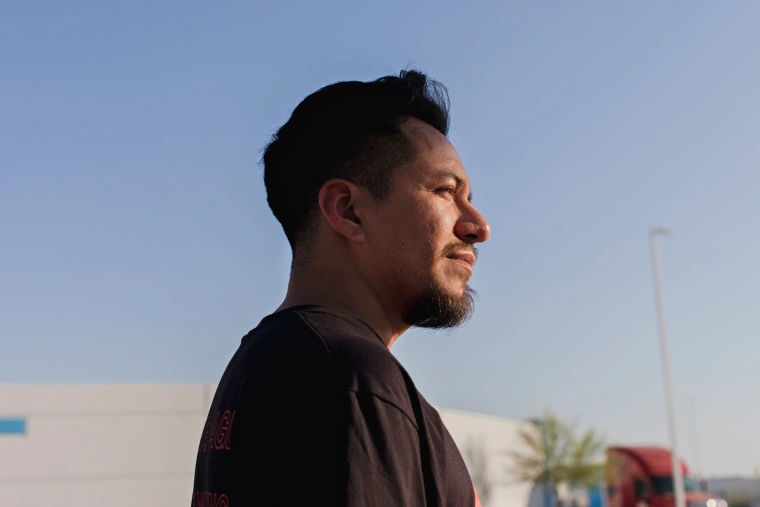Daniel Rivera was soaked in sweat when he got into his car in San Bernardino, California, one evening last month. The outside temperature was finally dropping below 100 degrees as he turned on the air conditioning. At first, it didn’t feel much different than standing near the fans by the loading docks at the Amazon air hub where he’d just spent 10 hours moving pallets.
That week had seen triple-digit highs as a climate change-fueled heat wave smashed two months of global records. This summer is Rivera’s third at the warehouse, but he wondered whether he could handle a fourth.
“The way they’re pressing their associates, combined with the extreme heat,” he said, a cold water bottle against his forehead, “it’s just due for a disaster.”
Two months earlier, Rivera had pleaded with regulators at a workplace safety hearing to finally implement the indoor heat protections state lawmakers enacted in 2016. While California is still on track to becoming the third state to impose such standards, rulemaking has taken nearly seven years. The state has seen its four hottest summers in that time.
Rivera is among the roughly 1.8 million people who work in U.S. warehouses where fast-paced physical tasks like loading boxes can raise body temperatures to dangerous levels that many climate-control systems struggle to counter, researchers, advocates and authorities say. As e-commerce hastens a warehousing boom in some of the hottest parts of the country, regulations have lagged behind workplace heat risks that range from mild to deadly.
“We were concerned about heat with outdoor workers at the beginning of the Obama administration,” said Debbie Berkowitz, who served within it as a senior official for the Occupational Safety and Health Administration. “But as time went on, it was clear that indoor workers were suffering from heat stress,” too.
Washington is taking greater note. The Biden administration issued heat safety orders last month, and Democrats recently advanced new workplace protections. Union efforts, including a UPS labor deal set to air-condition vehicles for the first time, have added momentum. But as the 2024 presidential campaign revs up, policy efforts risk slowing even as the climate crisis intensifies.
“It’s heartbreaking to come in to work to hear that another co-worker, a potential friend, has fainted or needed medical attention from heat exhaustion,” Rivera said at the May hearing. “It’s a cycle that’s not going to stop until we put a real standard in place.”
Amazon has long disputed allegations that its warehouse employees are overworked or that conditions are unsafe and said the San Bernardino site hasn’t had a work-related heat illness this year.
Workplaces built for things, not people
The U.S. warehouse workforce nearly doubled between 2017 and 2022, making cavernous steel structures a much more common workplace at a time when offices have taken the opposite course.
In the years before the pandemic, between 300 million and 400 million square feet of warehouse space was under construction per quarter, according to the commercial real-estate research firm CoStar. That rate surged to 900 million by last year. Today, warehouses blanket 20 billion square feet of the country, up about 20% from a decade ago.
“The rise of e-commerce has been the main driver of the expansion of distribution centers,” said Adrian Ponsen, director of U.S. industrial analytics at CoStar. “If you want to be able to deliver goods to households’ doorstep within two days of them placing the order, then that means you need to have large facilities holding a lot of inventory on hand within a two-day drive of all of your customers.”
Covid-19 accelerated the trend, as demand for physical goods surged during lockdowns and global supply chains buckled under the pressure. As the economy reopened, many U.S. businesses reconfigured their logistics, bringing some far-flung operations home.
The average U.S. warehouse measures about 36,300 square feet, up nearly 15% from a decade ago, according to CoStar. Newer ones are far bigger, with 30-to-40-foot ceilings and footprints of “10 to 20 football fields,” Ponsen said. “It’s almost like air conditioning an entire farm,” he said of the challenge of doing so. Robust cooling measures are usually reserved for perishables like produce or medicines.
“When the space is for food, they maintain warehouses at a certain temperature because the government checks to make sure the food doesn’t spoil,” veteran warehouse worker Victor Ramirez said in Spanish.
Of the 10 warehouses across California’s Inland Empire where he has worked since 2004, Ramirez recalled one with air conditioning in the work area: a major retailer facility that handled frozen and refrigerated products, where even delivery containers were kept out of the sun. His current workplace is a packaging company facility that feels cool only in the break area.
Many facilities are prone to hot spots, particularly on upper levels and by loading dock doors, according to workers, regulators and industry experts. Common climate-control measures like fans can improve air flow but usually don’t reduce internal temperatures much. Even in warehouses with cooling systems, some indoor areas can exceed 80 degrees on hot days.
One week last summer when outdoor highs ranged from 106 to 112 degrees in San Bernardino, workers at the Amazon air hub measured indoor temperatures as high as 89, according to a report by the Warehouse Worker Resource Center, a nonprofit advocacy group in the Inland Empire.
Amazon disputed the readings, saying indoor temperatures didn’t surpass 78 degrees that week or 77 degrees in Rivera’s work area the day he spoke with NBC News. The San Bernardino site is “temperature controlled with full air conditioning,” according to Maureen Lynch Vogel, a company spokesperson.
“Our heat-related safety protocols are robust and often exceed industry standards and federal OSHA guidance,” she said. “Amazon is one of only a few companies in the industry to have installed climate control systems in our fulfillment centers and at every air hub,” including the San Bernardino one, she said.
Nonbinding federal guidelines warn that heat-related illnesses become risky for those doing “strenuous work” when the “wet bulb globe temperature” — a metric that factors in humidity, wind speed and radiant heat from sunlight and machinery — passes 77 degrees. California’s proposed indoor heat rule would kick in at 82 degrees.
Of the five fastest-growing warehouse construction markets — Dallas, the Inland Empire, Houston, Chicago and Atlanta, respectively, according to CoStar — four are in the Sun Belt, which has seen both rapid population growth and scorching heat in recent years. The demographic influx has required more inventory space to serve retail customers, often in spread-out areas with large parcels of undeveloped land, CoStar’s Ponsen said.
Albertsons, Amazon, Lowes, Marshalls, Target, Walmart and other major brands all operate out of massive warehouses exceeding 1 million square feet in the Atlanta, Dallas, Houston or Phoenix areas — some in more than one of those markets — according to the research firm Predik Data-Driven.
While Amazon built the San Bernardino facility where Rivera works, many companies that use warehouse space frequently rent it from others, and CoStar data shows tenants pay for electricity in more than 95% of industrial leases signed this year.
— CutC by nbcnews.com


